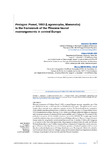| dc.contributor.author | Čermák, Stanislav | |
| dc.contributor.author | Angelone, Chiara | |
| dc.contributor.author | Moncunill-Solé, Blanca | |
| dc.date.accessioned | 2021-10-05T08:07:02Z | |
| dc.date.available | 2021-10-05T08:07:02Z | |
| dc.date.issued | 2021-06-28 | |
| dc.identifier.citation | Čermák S., Angelone C. & Moncunill-Solé B. 2021. — Prolagus Pomel, 1853 (Lagomorpha, Mammalia) in the framework of the Pliocene faunal rearrangements in central Europe. Comptes Rendus Palevol 20 (28): 597-617. https://doi.org/10.5852/cr-palevol2021v20a28 | es_ES |
| dc.identifier.issn | 1631-0683 | |
| dc.identifier.issn | 1777-571X | |
| dc.identifier.uri | http://hdl.handle.net/2183/28565 | |
| dc.description.abstract | [Abstract] Pliocene occurrences of Prolagus Pomel, 1853 in central Europe represent anomalies out of the peri-Mediterranean area, at that time the core distribution of the genus. Though known for several decades, those materials never underwent a general revision. The detailed analysis and comparison of all available materials performed here revealed two phenotypic entities: 1) Prolagus bilobus Heller, 1936 (Gundersheim localities, Raciszyn 1), for which were defined additional diagnostic characters and ontogenetic patterns of variation (d3/p3 and mandible); and 2) Prolagus sp. (Beremend 26/39), probably a new species. All the available occurrences are dated to MN15b. The morphological trends towards the reduction of p3 entoconid and of enamel folding evidenced in Pliocene Prolagus of western Europe cannot be recognized in coeval central European forms. Evidently, P. bilobus and Prolagus sp. do not pertain to the western European clade, whose separation is known since the early late Miocene. We hypothesize that at least P. bilobus originated from a dispersal of Prolagus from south-eastern regions of Europe rather than from an autochthonous speciation of isolated populations left as a relict after the southward displacement of Prolagus distribution area. The dispersal is likely to be related to the Pliocene global environmental changes during which extensive faunal rearrangements took place in Europe, in particular to those near the early/late Pliocene boundary. | es_ES |
| dc.description.abstract | [Résumé] Prolagus Pomel, 1853 (Lagomorpha, Mammalia) dans le cadre des réarrangements fauniques du Pliocène de l’Europe centrale. Le peu de données dont nous disposons sur le Prolagus Pomel, 1853 du Pliocène d’Europe centrale représentent des anomalies dans la distribution géographique du genre, qui, à cette époque, est limité à la zone péri-Méditerranéenne. Bien que la présence de Prolagus dans le Pliocène d’Europe centrale est connue depuis plusieurs décennies, de tels matériels n’ont jamais fait l’objet d’une révision générale. Une analyse détaillée et une comparaison de tous les matériels disponibles étudiés ici ont permis d’identifier deux éntités phénotypiques : 1) Prolagus bilobus Heller, 1936 à Gundersheim (plusieurs localités) et Raciszyn 1, pour lequel des caractères diagnostiques additionnels et des modèles ontogénétiques de variation (d3/p3 et mandibule) ont été définis ; et 2) Prolagus sp. à Beremend 26/39, qui représente probablement une nouvelle espèce. Toutes les occurrences disponibles sont datées du MN15b. Les tendances morphologiques vers une réduction de l’entoconide de p3 et une diminution du repli de l’émail, mises en évidence dans les espèces pliocènes de Prolagus d’Europe occidentale, n’ont pas été reconnues dans des formes contemporaines d’Europe centrale. Prolagus bilobus et Prolagus sp. n’appartiennent manifestement pas au clade ouest-européen, dont la séparation est connue depuis le début du Miocène supérieur. Notre hypothèse est qu’au moins P. bilobus trouve son origine dans une dispersion des populations à partir de l’Europe sud-orientale plutôt que, comme on le croyait autrefois, dans une spéciation autochtone de populations isolées, laissées telles des vestiges à la suite du déplacement vers le sud de l’aire de distribution géographique de Prolagus. Cette dispersion est probablement liée aux changements environnementaux à l’échelle globale survenus au Pliocène, et responsables de changements environnementaux globaux pendant lesquels des réarrangements fauniques majeurs ont pris place en Europe, et particulièrement à la transition Pliocène inférieur/supérieur. | es_ES |
| dc.description.sponsorship | The study was supported by institutional support RVO67985831 of the Institute of Geology of the Czech Academy of Sciences. CA was supported by: Visiting Professor grant of the President’s International Fellowship Initiative of the Chinese Academy of Science; Spanish Agencia Estatal de Investigación and the European Regional Development Fund of the European Union (CGL2016-76431-P); CERCA Program, Generalitat de Catalunya; Grant to Department of Science, Roma Tre
University (MIUR-Italy Dipartimenti di Eccellenza, ART. 1, C. 314-337 L. 232/2016). BMS was supported by Xunta de Galicia (ED481B 2018/046, Axudas á etapa postdoutoral da Xunta de Galicia 2018-Modalidade A) | es_ES |
| dc.description.sponsorship | Czech Academy of Sciences, Institute of Geology; RVO67985831 | es_ES |
| dc.description.sponsorship | Xunta de Galicia; ED481B 2018/046 | es_ES |
| dc.language.iso | eng | es_ES |
| dc.publisher | Muséum National d'Histoire Naturelle (París) | es_ES |
| dc.relation | info:eu-repo/grantAgreement/AEI/Plan Estatal de Investigación Científica y Técnica y de Innovación 013-2016/CGL2016-76431-P/ES/DINAMICA DE LA PALEOBIODIVERSIDAD DE LAS FAUNAS DE VERTEBRADOS FOSILES DEL VALLES-PENEDES Y COMPARACION CON OTRAS CUENCAS MIOCENAS | |
| dc.relation.uri | https://doi.org/10.5852/cr-palevol2021v20a28 | es_ES |
| dc.subject | Prolagidae | es_ES |
| dc.subject | Prolagus bilobus | es_ES |
| dc.subject | Gundersheim | es_ES |
| dc.subject | Raciszyn 1 | es_ES |
| dc.subject | Beremend | es_ES |
| dc.subject | Palaeobiogeography | es_ES |
| dc.subject | Paléobiogéographie | es_ES |
| dc.title | Prolagus Pomel, 1853 (Lagomorpha, Mammalia) in the Framework of the Pliocene Faunal Rearrangements in Central Europe | es_ES |
| dc.type | info:eu-repo/semantics/article | es_ES |
| dc.rights.access | info:eu-repo/semantics/openAccess | es_ES |
| UDC.journalTitle | Comptes Rendus Palevol | es_ES |
| UDC.volume | 20 | es_ES |
| UDC.issue | 28 | es_ES |
| UDC.startPage | 597 | es_ES |
| UDC.endPage | 617 | es_ES |
| dc.identifier.doi | 10.5852/cr-palevol2021v20a28 | |






